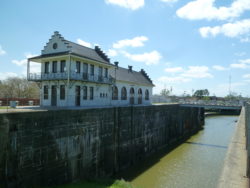Plaquemine Lock
The Bayou Plaquemine Lock once allowed ships to pass from the Mississippi River through the bayou to Louisiana's interior.

Photo by Dan Troyka.
The Bayou Plaquemine Lock.
The Bayou Plaquemine Lock allowed ships to pass from the Mississippi River through the bayou to Louisiana’s interior via the Atchafalaya Basin. The steel gates had a lift of fifty-one feet, the highest freshwater lift of any lock in the world at the time of its construction. When construction on the Plaquemine lock began in 1895, the dynamite blasts were sufficiently powerful to cause structural damage to St. John the Evangelist Church. The lock, completed in 1909, used a gravity-flow system until hydraulic pumps were installed in the late 1940s. The lock closed permanently in 1961, replaced by the larger Port Allen Lock, which was built to accommodate both increased Mississippi River traffic (during and after World War II) as well as bigger ships.
The lock’s pump house has an exterior facing of white glazed brick, a material chosen for its ability to reflect light, as there were no lighthouses along the river. The lock house has large, round-arched windows and a cast-iron balcony; its prominent stepped gables are said to reflect the Dutch heritage of designer Colonel George Goethals (1858–1928) of the Army Corps of Engineers. Goethals later became the chief engineer for the Panama Canal and the first civil governor of the Canal Zone. The pump house now serves as a museum, with displays of early river traffic and a working scale model of the lock operation. It now is called the Gary J. Hebert Memorial Lockhouse, named for the late Iberville Parish newspaper publisher who led the campaign to restore and preserve the abandoned lock as a historic site.
Adapted from Karen Kingsley’s Buildings of Louisiana, part of the Buildings of the United States series commissioned by the Society of Architectural Historians (www.sah.org) and published by Oxford University Press.
